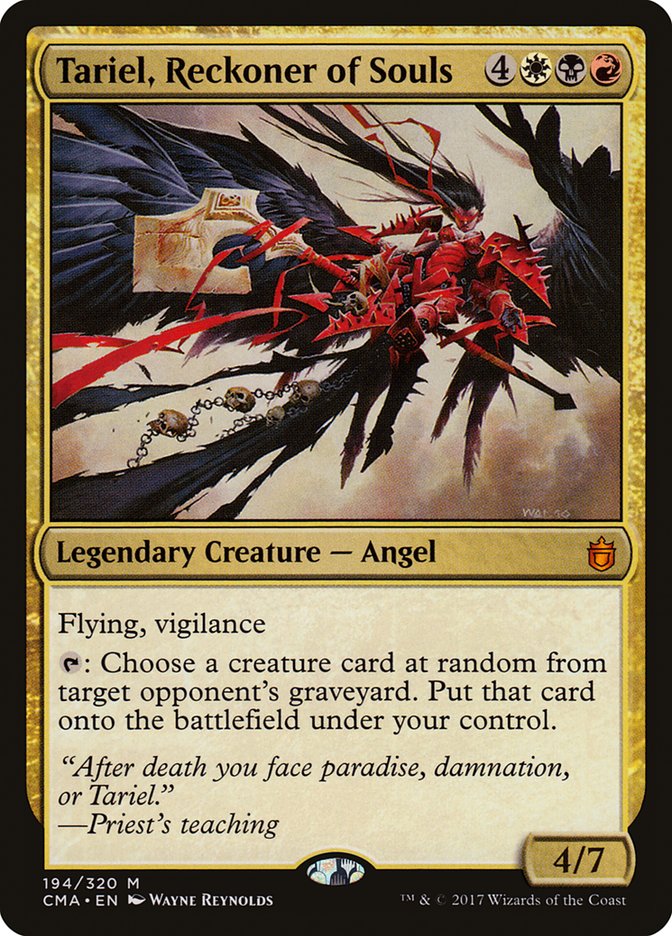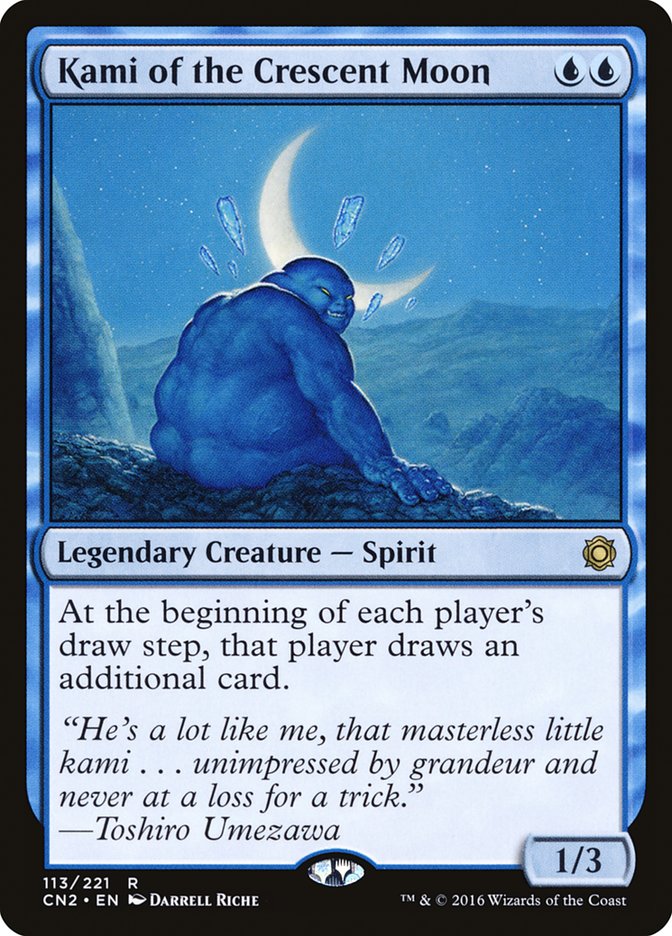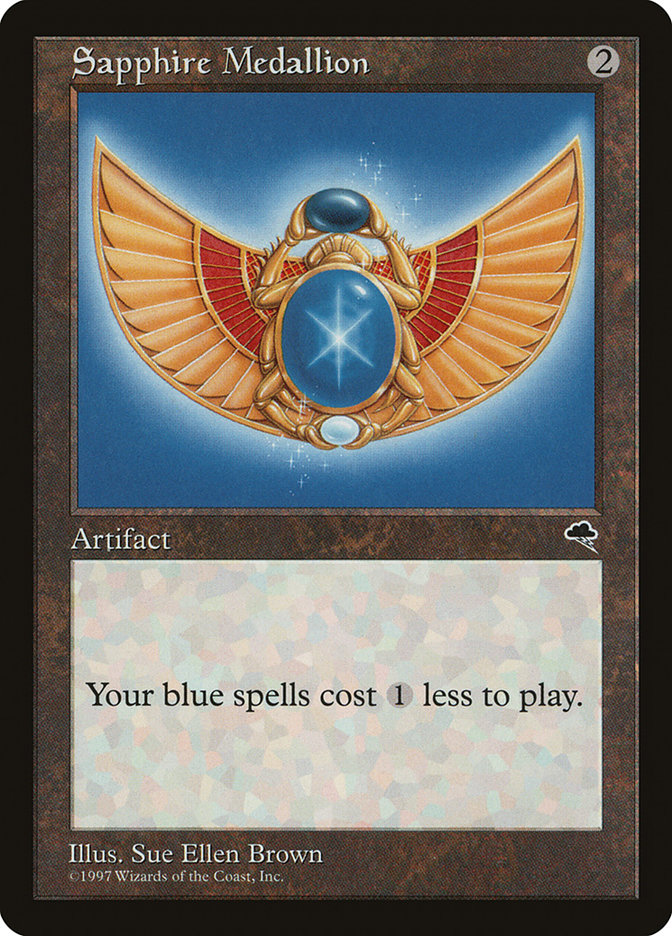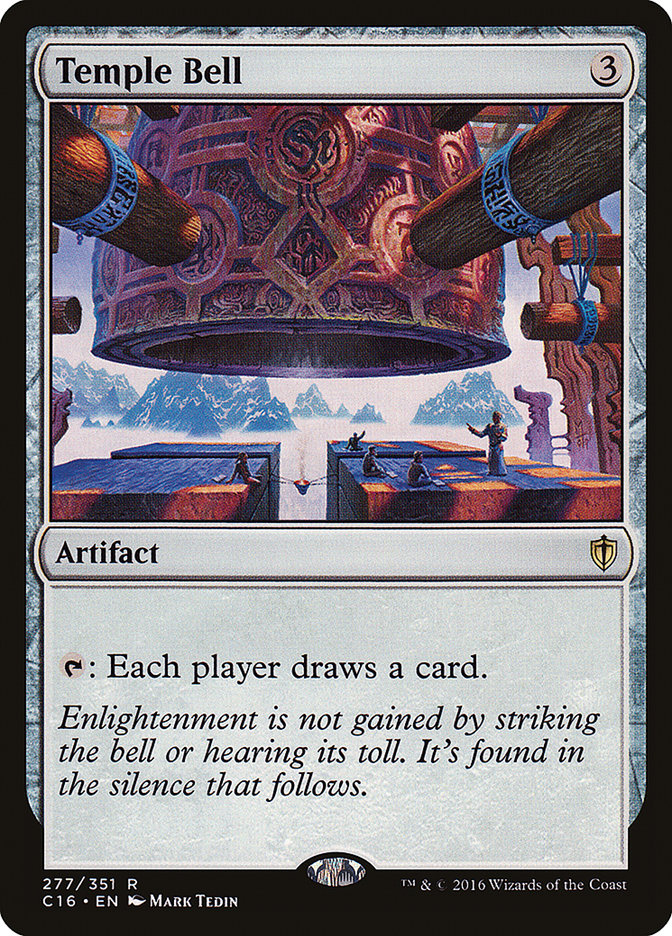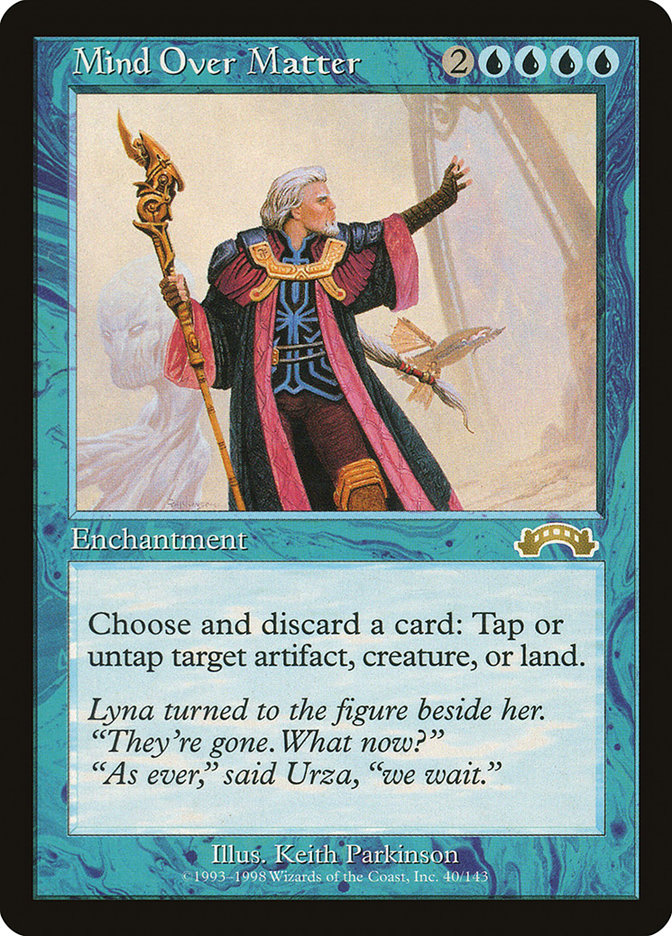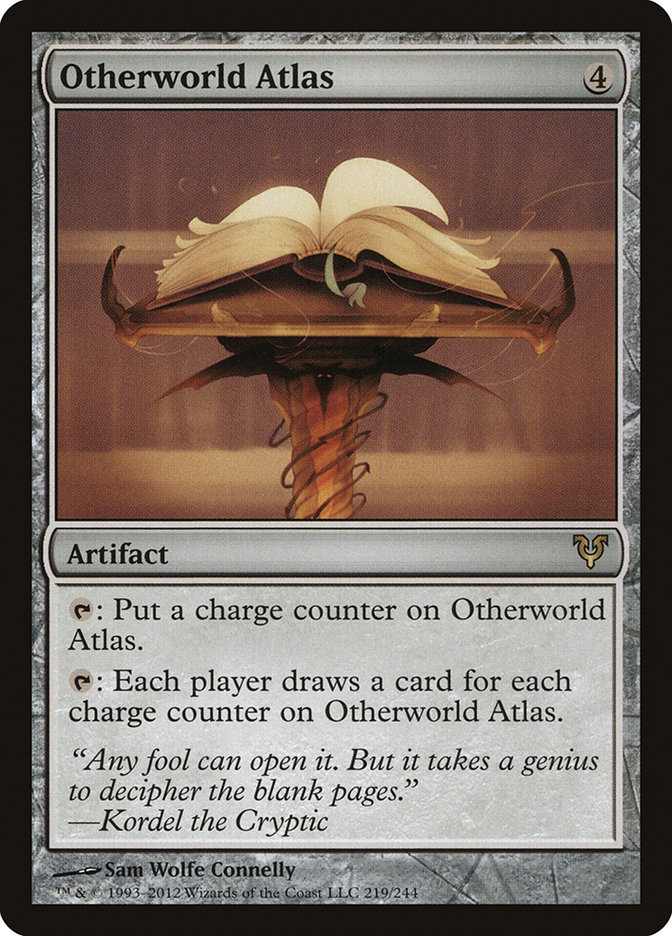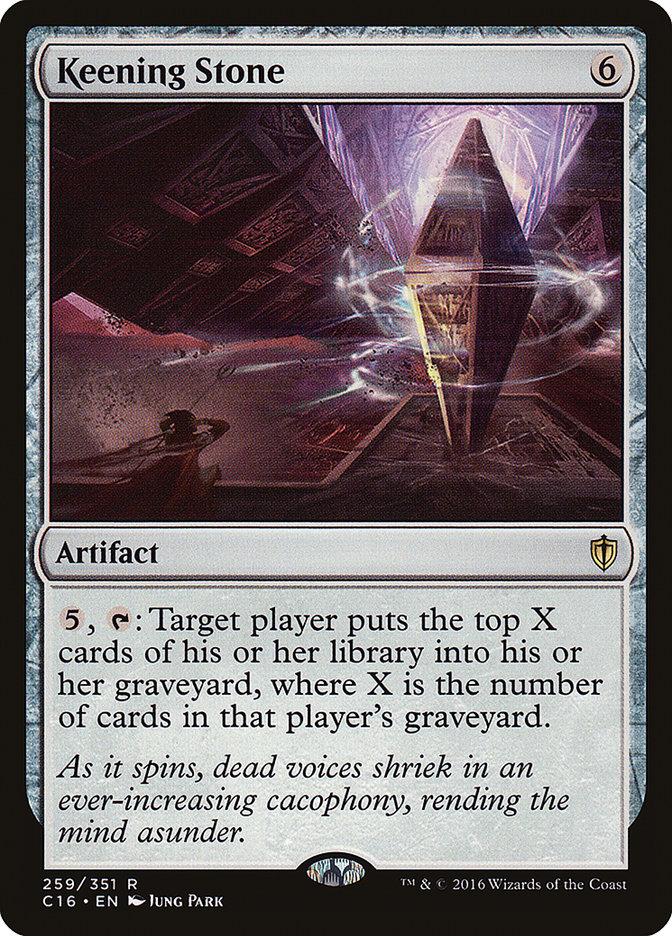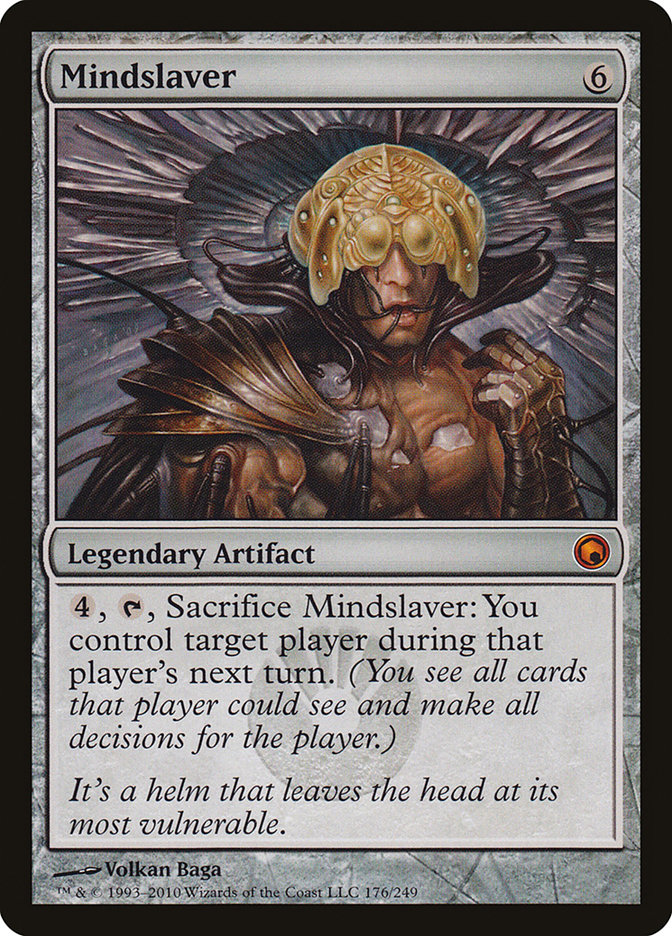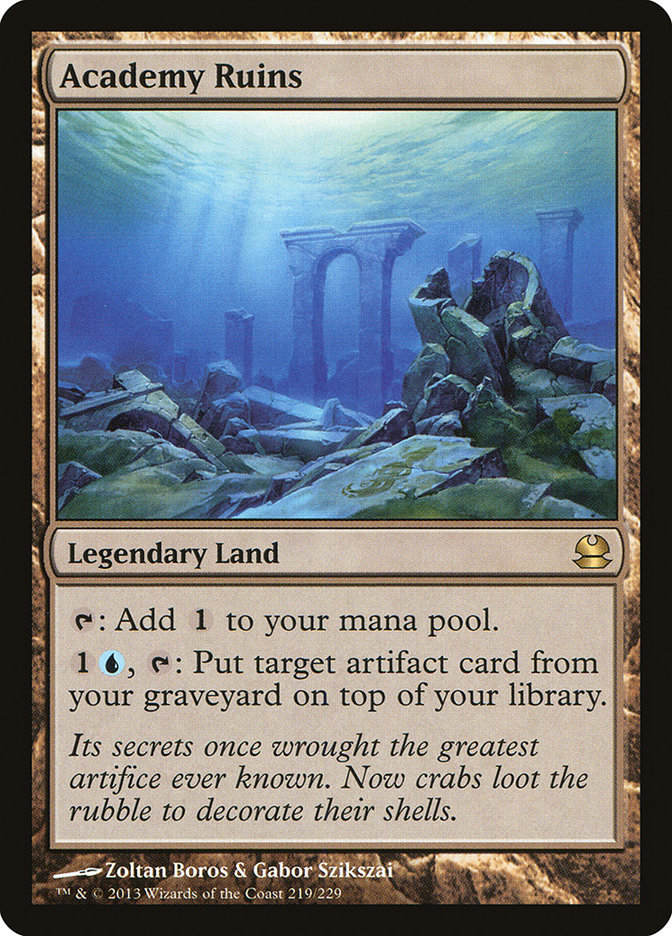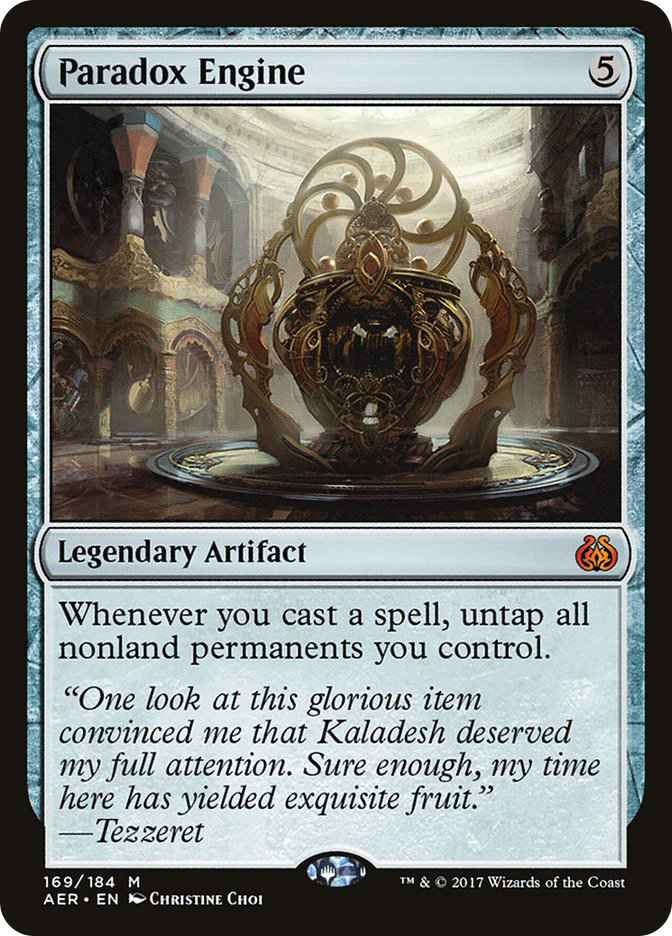And I’ve been doing just fine.
A Killers reference instead of a nu metal one to kick things off. Guess you didn’t know you were dealing with the man right here.
This week I wanted to talk about a mini-project that I’ve been working on over the last few months. It began when I discussed a Tariel, Reckoner of Souls deck that I used to have right around when the original Innistrad block came out. Tariel was a lot of fun, but it wasn’t as competitive as I would have liked it to be, so I scrapped her. This led me down a dark path of building hyper-combo-oriented decks that would win as early as Turn 3. These decks were cartoonishly boring, and I began selling them off in a never-ending cycle of trying to find whatever would kill opponents faster. This was also cartoonishly boring. Eventually I stopped playing Commander altogether for about a year, resigning that I wasn’t capable of having fun unless I was winning.
That philosophy sucked, so I worked on a new one.
Over the last year I’ve put together seven decks that were meant to cover the spectrum of fun, yet competitive. I could play games that lasted hours while still being fully capable of winning quickly if I put my mind to it. Tariel, Reckoner of Souls symbolized my desire to return to a more casual style of Commander, where I played huge creatures, flashy spells, and didn’t care as much about winning as I did about having a good time.
As revelations seem to do, my focus on resurrecting Tariel from the depths of obscurity brought me back to another deck I had the same problem with: Kami of the Crescent Moon, a card I can with absolute certainty say they gave that name to because his little butt is sticking out.
We’re mature here, kiddies. It’s fine.
Kami of the Crescent Moon was a deck I put together around five or six years ago. It was a mill deck meant for 1v1 play. It played platinum hits like Traumatize, Increasing Confusion, and Howling Mine, and it often gave my opponents tons of fuel to kill me with. Kami all those years ago was a lot like handing a person that hates you a baseball bat, turning your back, and then saying super-disparaging things about their mother. You know what’s coming, and it’s entirely your fault as to why they’re beating you senseless, but you did this to yourself, so no one is going to feel badly for you. That was Kami.
But it was fun. It was so much fun.
How did it win? It didn’t. I mean, sure, I would try to mill people out, but then I wouldn’t because I didn’t want to play the tandem of Temple Bell and Mind Over Matter. No. I was way too indignant to include an auto-win in my fun deck. Aw hell no. We were going to hope Psychosis Crawler got there, which it never did. My opponents had a ball. They were drawing three, four, sometimes five extra cards per turn. They’d keep me alive so they could keep churning out gas, and I’d do my best to kill them with the same gusto that a single ant would have against a pride of Ravenous Chupacabras.
Sometimes my spells would cost less due to Sapphire Medallion. That was cool at least.
For the most part, Kami of the Crescent Moon was an extremely underwhelming experiment that resulted in utter failure. So why am I revisiting it?
Aside from a good amount of upgrades that the archetype received, I wanted to revive a deck that has stuck out in my mind over the years as one that I never gave the proper attention to. My first foray into Kami was far too gimmicky and weak. In 1v1 Commander, milling without a lot of ways to slow down your opponent isn’t viable, and that strategy only gets worse when you introduce it to multiplayer environments. The deck needed to completely overhaul its strategy if it wanted to be:
A) Competitive
B) Viable
C) Fun
Losing isn’t that much fun, but merely being a spectator is probably worse. Memorable games are the goal.
This brought me to understand that these goals can align if we change philosophies and focus on what Kami of the Crescent Moon can do well absent dedicating yourself to pure mill. When I composed a question on Facebook and Twitter regarding this competitive Kami deck, I was met mostly with intrigue that such a thing was possible. I’m here to tell you that it is.
The strengths of a deck like Kami rest in the fact that most people aren’t going to take you seriously. They’re going to give your commander a lot of free uptime because they like drawing cards, and that’s something we want. Most importantly, though, Kami is cheap. At two mana, your commander is very easy to reliably cast on Turn 2. From there, with reliance on a lot of artifact mana, you’ll find yourself able to back up most plays with a large amount of countermagic and battlefield control. We’re no longer worrying about mill as much as we care about digging for our combo pieces, drawing a ton of gas, and keeping the battlefield on ice.
And yes, this time we’re playing Temple Bell and Otherworld Atlas alongside Mind Over Matter.
Creatures (11)
- 1 Trinket Mage
- 1 Venser, Shaper Savant
- 1 Kozilek, Butcher of Truth
- 1 Psychosis Crawler
- 1 Phyrexian Metamorph
- 1 Snapcaster Mage
- 1 Thing in the Ice
- 1 Torrential Gearhulk
- 1 Padeem, Consul of Innovation
- 1 Trophy Mage
- 1 Baral, Chief of Compliance
Planeswalkers (2)
Lands (33)
Spells (53)
- 1 Sensei's Divining Top
- 1 Mana Drain
- 1 Counterspell
- 1 Mind Over Matter
- 1 Force of Will
- 1 Propaganda
- 1 Howling Mine
- 1 Mana Vault
- 1 Sol Ring
- 1 Copy Artifact
- 1 Meekstone
- 1 Library of Leng
- 1 Black Vise
- 1 Mana Crypt
- 1 Forbid
- 1 Merchant Scroll
- 1 Frantic Search
- 1 Crawlspace
- 1 Sculpting Steel
- 1 Mindslaver
- 1 Gilded Lotus
- 1 Fabricate
- 1 Arcane Denial
- 1 High Tide
- 1 Evacuation
- 1 Long-Term Plans
- 1 Mystic Remora
- 1 Sapphire Medallion
- 1 Anvil of Bogardan
- 1 Misdirection
- 1 Iron Maiden
- 1 Thran Dynamo
- 1 Rhystic Study
- 1 Muddle the Mixture
- 1 Pact of Negation
- 1 Cryptic Command
- 1 Font of Mythos
- 1 Expedition Map
- 1 Keening Stone
- 1 Jace's Erasure
- 1 Temple Bell
- 1 Venser's Journal
- 1 Flusterstorm
- 1 Otherworld Atlas
- 1 Cyclonic Rift
- 1 Swan Song
- 1 Dictate of Kruphix
- 1 Aetherspouts
- 1 Well of Ideas
- 1 Sphinx's Tutelage
- 1 Mystic Confluence
- 1 Thought Vessel
- 1 Engulf the Shore

What should stand out immediately is that this isn’t the kind of mill deck you may be used to when you think of the archetype. We’re absent staples like Traumatize, Fraying Sanity, Shelldock Isle, Sanity Grinding, or other tools commonly used to flip an opponent’s library into their graveyard. That strategy is what got me into this mess the first time I built Kami.
The issue with mill in Commander is that it isn’t remotely difficult for players to dump their hands. Commander is largely a format dictated by the amount of ramp a player is capable of producing, which is why you see things like Mana Crypt, Mana Vault, Grim Monolith, and Sol Ring in almost every competitive list that gets created. Proactively milling, while fun and entertaining, isn’t going to stop them from bashing your face in. Tools like Crawlspace or Meekstone are a start, but they won’t keep Voltron decks from killing you in a single turn with one attack step. Your job is to actively control the tempo of the game while passively killing them thanks to your mill and static cards like Iron Maiden or Black Vise.
This brings me to the win conditions, which I will explain for those of you unfamiliar with Kami of the Crescent Moon.
This combo is achieved with two crucial pieces in your deck, Temple Bell and Otherworld Atlas. Both allow you to draw cards along with your opponent. They keep a table happy and not insistent on targeting you. Mind Over Matter will kill the table by untapping one of the card-drawing artifacts with the card you just drew from it. You’ll repeat this process indefinitely, eventually drawing your Kozilek, Butcher of Truth, which you will discard to shuffle in your library, ensuring you do not mill yourself out. This can be done an arbitrarily large number of times, rendering almost all forms of interaction meaningless aside from Krosan Grip.
The very expensive artifact is partially why we play Trophy Mage. Keening Stone is a way to devour massive chunks of your opponent’s library at a time. I would recommend saving it and casting it very late, to such a point where an end-of-turn activation along with one during your turn is enough to finish off a player.
Mindslaver gives you the chance to take a player’s turn over. In conjunction with Academy Ruins, you can put the Mindslaver back on top of your library after using it and take a player’s turn again. Repeat at will.
I know what you’re saying: “But Mark, you said you don’t like playing with decks that kill via arbitrarily large combos.” You’re totally right, astute reader. I don’t. However, Kami offers us a rare opportunity to play some highly interactive Magic with a table or 1v1. Let me explain.
In testing, games with Kami will go long. Pretty long. Quite long. They’ll take a while. While you sculpt your hand through numerous draw engines and attempt to put the kibosh on big spells with your countermagic, you’ll be locked in a constant struggle to stay alive. All of your card draw feeds your opponent as well, and with most of your Howling Mine-effect type cards, they’ll have the initiative when it comes to drawing those extra cards. The downside is that, say, with Font of Mythos, they’ll pick up two extra cards and then slam a Return to Dust or some other artifact hoser, leaving you with nothing and them up a few extra cards.
Games will almost never come down to “I cast a Temple Bell on Turn 3 and power out a Mind Over Matter on Turn 4…cool, I win” game state. This deck only plays Long-Term Plans and Fabricate as tutors (Mystic Tutor doesn’t find a combo piece outright), so you’re not swimming in ways to produce your combos independent of naturally drawing the pieces, and even then, a player can respond to you casting Mind Over Matter and blow up your Otherworld Atlas, setting you back multiple turns until you find another way to win. You’ll always be surveying the battlefield, open mana, and correct situations to try to “go off,” and even if the path looks clear, victory isn’t assured. This deck takes a lot of patience and understanding to make it purr.
In terms of cards that I would like to add, the biggest one is Paradox Engine. As is the case with Engine, it is one of the most powerful cards being played across Competitive Commander right now. In this deck it gives you a constant way to untap your mana-producing artifacts, but more importantly, it would allow us, in conjunction with those artifacts, to go nuclear with something like Keening Stone or multiple untapping instances for Temple Bell or Otherworld Atlas. Paradox Engine makes an unfortunate amount of sense in this deck, but I can’t find a cut that I’m comfortable with aside from Well of Ideas. Still, I’d like to play with it more before I make my choice. We all know how this one will play out.
Putting Kami of the Crescent Moon back together has been a joy thus far, and I’m looking forward to having it as a part of my Commander arsenal. If anything, alongside Tariel, Reckoner of Souls, they are reminders to not give up on decks just because they don’t meet our first level of expectations. Eventually they can become something fun and fantastic to play at competitive tables.
Be sure to give me some recommendations for Kami, especially if you have any input on what a good cut would be for Paradox Engine. If you want to go a level deeper, tell me about an unconventional commander that you’ve been able to work on and create unexpected success with.
Sometimes it’s just about playing good old fashioned Magic: Counterspells and Island.
You know.
The kind you used to play when you were young.


